
Concept explainers
(a)
Interpretation:
The compound from given spectra is to be identified.
Concept Introduction:
In the IR spectroscopy, change in the dipole moment produces absorption of energy. All the functional group have different absorption frequency based on which they can be differentiated. For carbonyl
Answer to Problem 21.55AP
The structure of compound is shown below.
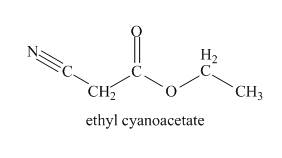
Explanation of Solution
The odd molecular mass of the compound indicates that it contains odd number of nitrogen atoms. Hydroxamate test is given by esters. So, compound contains ester group. The IR band at

Figure 1
The given compound is ethyl cyanoacetate.
(b)
Interpretation:
The compound from given spectra is to be identified.
Concept Introduction:
In the IR spectroscopy, change in the dipole moment produces absorption of energy. All the functional group have different absorption frequency based on which they can be differentiated. For carbonyl
Answer to Problem 21.55AP
The structure of given compound is shown below.
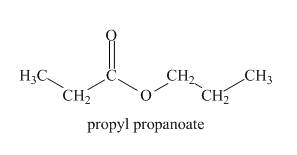
Explanation of Solution
The given compound gives IR absorption peak at

Figure 2
The given compound is propyl propanaote.
(c)
Interpretation:
The compound from given spectra is to be identified.
Concept Introduction:
In the IR spectroscopy, change in the dipole moment produces absorption of energy. All the functional group have different absorption frequency based on which they can be differentiated. For carbonyl
Answer to Problem 21.55AP
The structure of given compound is shown below.
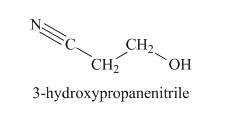
Explanation of Solution
The strong absorption peak in IR at

Figure 3
The given compound is
(d)
Interpretation:
The compound from given spectra is to be identified.
Concept Introduction:
In the IR spectroscopy, change in the dipole moment produces absorption of energy. All the functional group have different absorption frequency based on which they can be differentiated. For carbonyl
Answer to Problem 21.55AP
The structure of given compound is shown below.
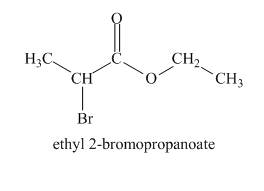
Explanation of Solution
The two molecular ion peaks at

Figure 4
The given compound is
(e)
Interpretation:
The compound from given spectra is to be identified.
Concept Introduction:
In the IR spectroscopy, change in the dipole moment produces absorption of energy. All the functional group have different absorption frequency based on which they can be differentiated. For carbonyl
Answer to Problem 21.55AP
The structure of given compound is shown below.

Explanation of Solution
The compound has odd molecular mass which indicates the presence of nitrogen atom. The IR absorption peak at

Figure 5
The given compound is
(f)
Interpretation:
The compound from given spectra is to be identified.
Concept Introduction:
In the IR spectroscopy, change in the dipole moment produces absorption of energy. All the functional group have different absorption frequency based on which they can be differentiated. For carbonyl
Answer to Problem 21.55AP
The structure of given compound is shown below.
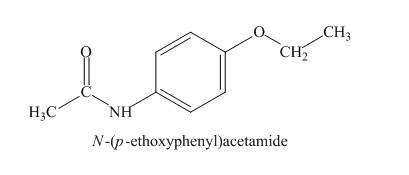
Explanation of Solution
The absorption in IR at ![]() indicates the presence of amide group and at
indicates the presence of amide group and at
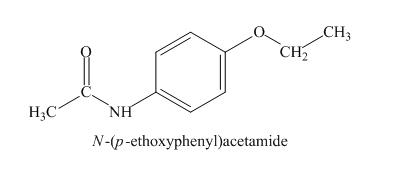
Figure 6
The given compound is
(g)
Interpretation:
The compound from given spectra is to be identified.
Concept Introduction:
In the IR spectroscopy, change in the dipole moment produces absorption of energy. All the functional group have different absorption frequency based on which they can be differentiated. For carbonyl
Answer to Problem 21.55AP
The structure of given compound is shown below.
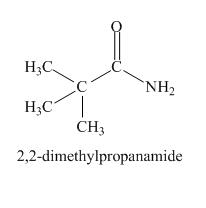
Explanation of Solution
The odd molecular mass of the compound indicates it contains nitrogen atom. The IR absorption peak at

Figure 7
The given compound is
Want to see more full solutions like this?
Chapter 21 Solutions
Organic Chemistry Study Guide and Solutions
- How do I explain this? Thank you!arrow_forwardWhen an unknown amine reacts with an unknown acid chloride, an amide with a molecular mass of 163 g/mol (M* = 163 m/z) is formed. In the infrared spectrum, important absorptions appear at 1661, 750 and 690 cm. The 13C NMR and DEPT spectra are provided. Draw the structure of the product as the resonance contributor lacking any formal charges. 13C NMR DEPT 90 200 160 120 80 40 0 200 160 120 80 40 0 DEPT 135 T 200 160 120 80 40 0 Draw the unknown amide. Select Dow Templates More Fragearrow_forwardIdentify the unknown compound from its IR and proton NMR spectra. C4H6O: 'H NMR: 82.43 (1H, t, J = 2 Hz); 8 3.41 (3H, s); 8 4.10 (2H, d, J = 2 Hz) IR: 2125, 3300 cm¹ The C4H6O compound liberates a gas when treated with C2H5 MgBr. Draw the unknown compound. Select Draw с H Templates Morearrow_forward
- Please help with number 6 I got a negative number could that be right?arrow_forward1,4-Dimethyl-1,3-cyclohexadiene can undergo 1,2- or 1,4-addition with hydrogen halides. (a) 1,2-Addition i. Draw the carbocation intermediate(s) formed during the 1,2-addition of hydrobromic acid to 1,4-dimethyl-1,3-cyclohexadiene. ii. What is the major 1,2-addition product formed during the reaction in (i)? (b) 1,4-Addition i. Draw the carbocation intermediate(s) formed during the 1,4-addition of hydrobromic acid to 1,4-dimethyl-1,3-cyclohexadiene. ii. What is the major 1,4-addition product formed from the reaction in (i)? (c) What is the kinetic product from the reaction of one mole of hydrobromic acid with 1,4-dimethyl-1,3-cyclohexadiene? Explain your reasoning. (d) What is the thermodynamic product from the reaction of one mole of hydrobro-mic acid with 1,4-dimethyl-1,3-cyclohexadiene? Explain your reasoning. (e) What major product will result when 1,4-dimethyl-1,3-cyclohexadiene is treated with one mole of hydrobromic acid at - 78 deg * C ? Explain your reasoning.arrow_forwardGive the product of the bimolecular elimination from each of the isomeric halogenated compounds. Reaction A Reaction B. КОВ CH₂ HotBu +B+ ко HOIBU +Br+ Templates More QQQ Select Cv Templates More Cras QQQ One of these compounds undergoes elimination 50x faster than the other. Which one and why? Reaction A because the conformation needed for elimination places the phenyl groups and to each other Reaction A because the conformation needed for elimination places the phenyl groups gauche to each other. ◇ Reaction B because the conformation needed for elimination places the phenyl groups gach to each other. Reaction B because the conformation needed for elimination places the phenyl groups anti to each other.arrow_forward
- Five isomeric alkenes. A through each undergo catalytic hydrogenation to give 2-methylpentane The IR spectra of these five alkenes have the key absorptions (in cm Compound Compound A –912. (§), 994 (5), 1643 (%), 3077 (1) Compound B 833 (3), 1667 (W), 3050 (weak shoulder on C-Habsorption) Compound C Compound D) –714 (5), 1665 (w), 3010 (m) 885 (3), 1650 (m), 3086 (m) 967 (5), no aharption 1600 to 1700, 3040 (m) Compound K Match each compound to the data presented. Compound A Compound B Compound C Compound D Compoundarrow_forward7. The three sets of replicate results below were accumulated for the analysis of the same sample. Pool these data to obtain the most efficient estimate of the mean analyte content and the standard deviation. Lead content/ppm: Set 1 Set 2 Set 3 1. 9.76 9.87 9.85 2. 9.42 9.64 9.91 3. 9.53 9.71 9.42 9.81 9.49arrow_forwardDraw the Zaitsev product famed when 2,3-dimethylpentan-3-of undergoes an El dehydration. CH₂ E1 OH H₁PO₁ Select Draw Templates More QQQ +H₂Oarrow_forward
- Complete the clean-pushing mechanism for the given ether synthesia from propanol in concentrated sulfurica140°C by adding any mining aloms, bands, charges, nonbonding electron pairs, and curved arrows. Draw hydrogen bonded to cayan, when applicable. ore 11,0 HPC Step 1: Draw curved arrows Step 2: Complete the intend carved Q2Q 56 QQQ Step 3: Complete the intermediate and add curved Step 4: Modify the structures to draw the QQQ QQQarrow_forward6. In an experiment the following replicate set of volume measurements (cm3) was recorded: (25.35, 25.80, 25.28, 25.50, 25.45, 25.43) A. Calculate the mean of the raw data. B. Using the rejection quotient (Q-test) reject any questionable results. C. Recalculate the mean and compare it with the value obtained in 2(a).arrow_forwardA student proposes the transformation below in one step of an organic synthesis. There may be one or more reactants missing from the left-hand side, but there are no products missing from the right-hand side. There may also be catalysts, small inorganic reagents, and other important reaction conditions missing from the arrow. • Is the student's transformation possible? If not, check the box under the drawing area. • If the student's transformation is possible, then complete the reaction by adding any missing reactants to the left-hand side, and adding required catalysts, inorganic reagents, or other important reaction conditions above and below the arrow. • You do not need to balance the reaction, but be sure every important organic reactant or product is shown. + T G OH де OH This transformation can't be done in one step.arrow_forward

 Organic ChemistryChemistryISBN:9781305580350Author:William H. Brown, Brent L. Iverson, Eric Anslyn, Christopher S. FootePublisher:Cengage Learning
Organic ChemistryChemistryISBN:9781305580350Author:William H. Brown, Brent L. Iverson, Eric Anslyn, Christopher S. FootePublisher:Cengage Learning

